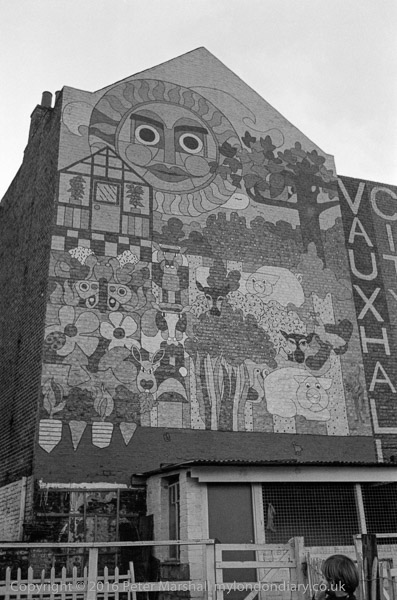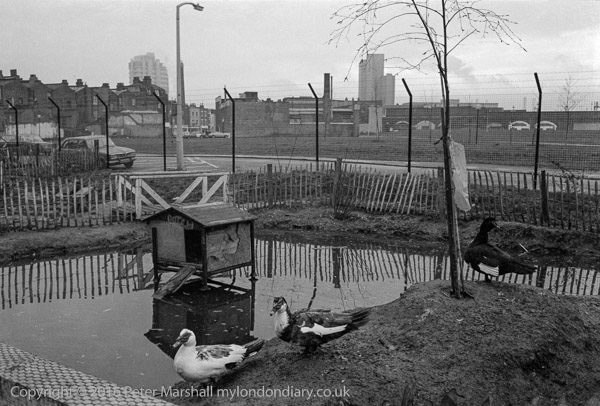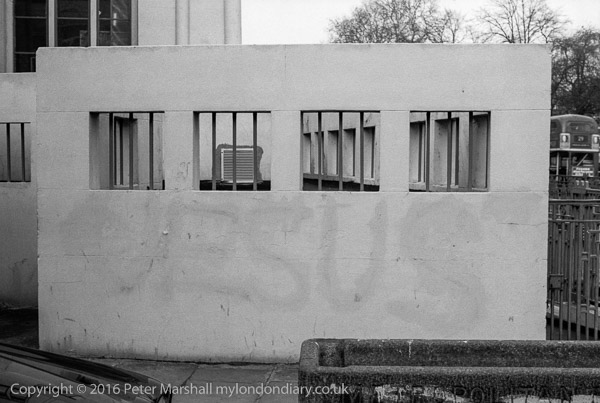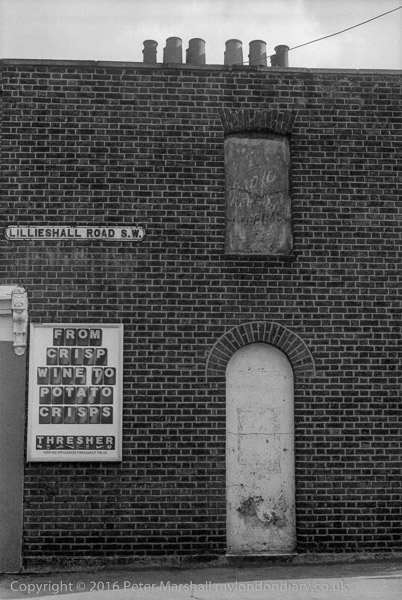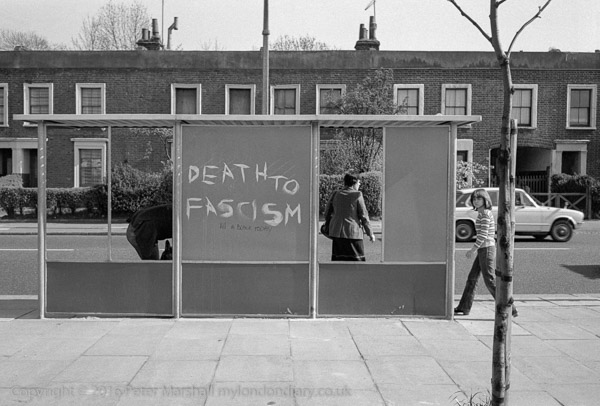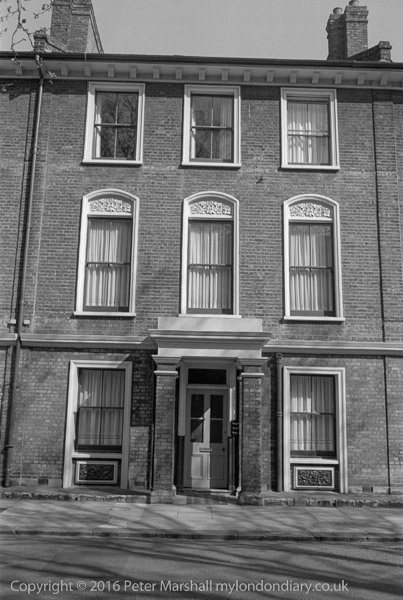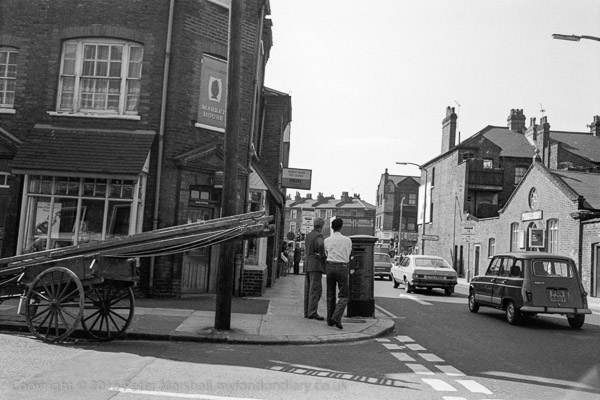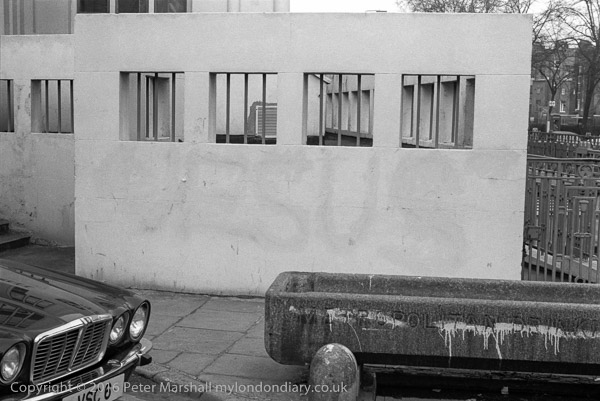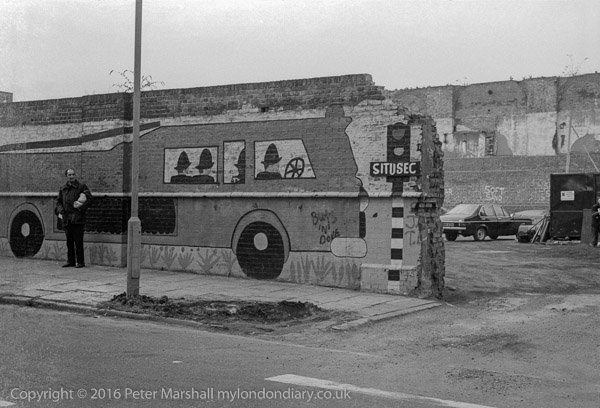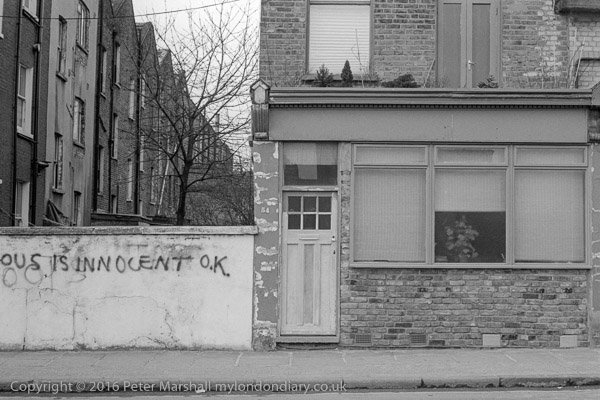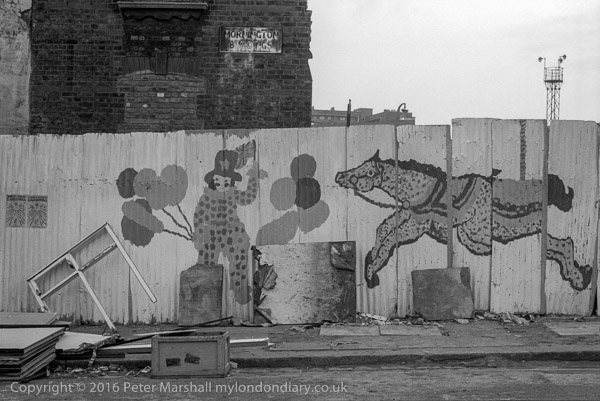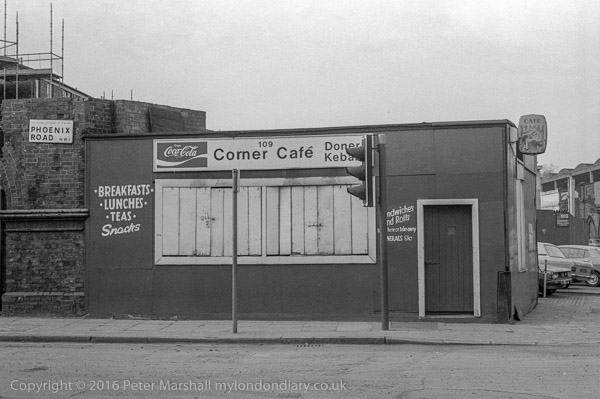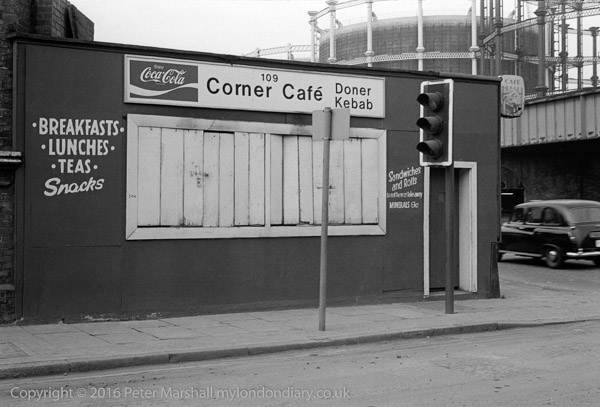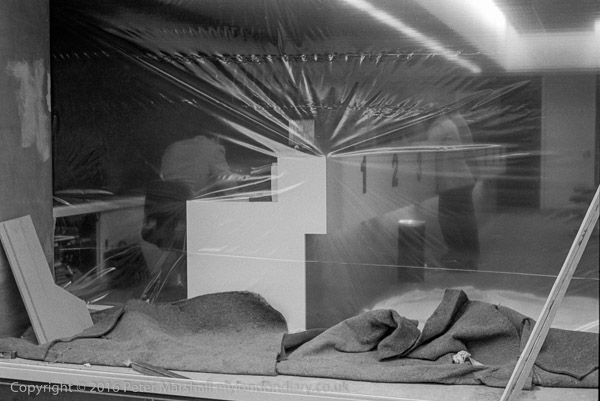The third set of black and white pictures I took in London in 1980 together with the stories about them first published on Facebook.
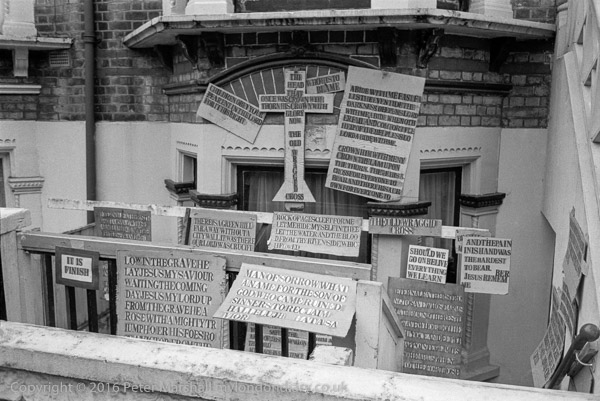
23u-41: house, notices, Christian, basement,
http://londonphotographs.co.uk/london/1980/23u-41.htm
Taken, again on the Minox, on a family outing to Brixton to an Open Day at the windmill which was then being restored. I didn’t take any black and white pictures of the windmill, but I think I may have taken a camera with colour film and made some family pictures with that, though I can’t at the moment find them.
We’d walked around Brixton in a slightly indirect way to get to the windmill, and on the way home I suggested another diversion, coming out from Blenheim Gardens and going across Brixton Hill to one of the roads opposite, perhaps Josephine Avenue.
A few years later I tried to go back and find this basement, but could not locate any properties in the area with similar short steps from the pavement up to the front door and down to a basement below. It may still be there somewhere, perhaps a little further away than I remember, or it may have been demolished.
I’d hoped to find it again, and perhaps to have stepped over the wall and gone down the steps to the door at the right and rung on the bell and found out more about the person who painstakingly created all of these signs with their curious mis-spelling such as ‘THE OLD WRAGGID CROSS’
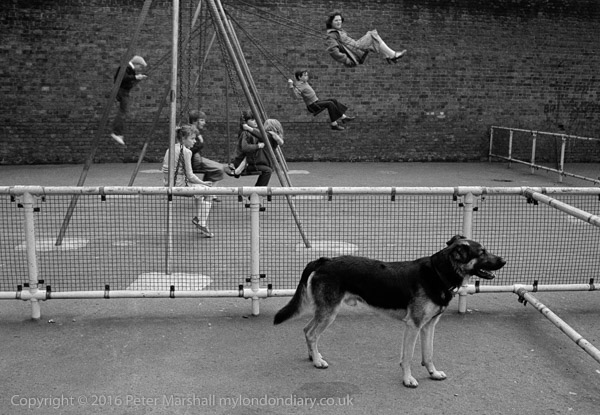
Playground, Brixton, Lambeth. 1980
23u-53: children, swings, dog,
http://londonphotographs.co.uk/london/1980/23u-53.htm
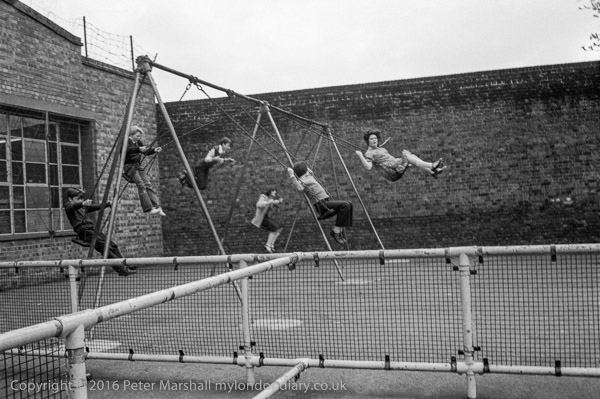
23u-54: children, swings, dog,
http://londonphotographs.co.uk/london/1980/23u-54.htm
I think this playground was close to Brixton Windmill in Blenheim Gardens. I had come with my family to visit the Windmill. My two young boys were too young to go on these swings even had they not been in used, and the dog didn’t seem too friendly.
It is a typical old-fashioned playground made when kids were made of tougher stuff and minor injuries from falling on tarmac and concrete were taken for granted.

24a-34: children, BMX, track, flats, Stockwell,
http://londonphotographs.co.uk/london/1980/24a-34.htm
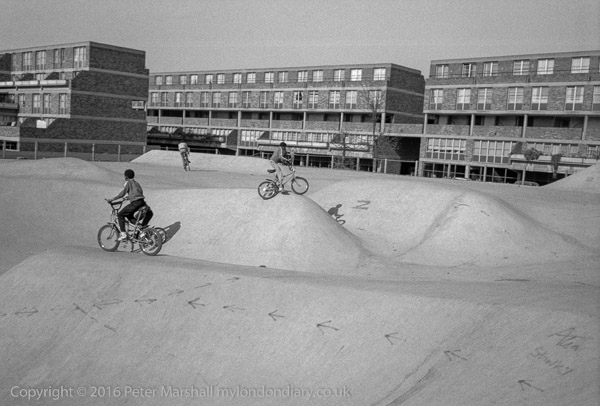
24g-42: children, BMX, bikes, track, flats,
http://londonphotographs.co.uk/london/1980/24g-42.htm
Stockwell Concrete Bowl Skatepark is still there at the corner of Stockwell Rd and Stockwell Park Walk, along with the flats behind on Benedict Rd, Barrett House, part of the Stockwell Park Estate, which was completed in 1976.
The estate got a bad reputation, particularly following the 1981 Brixton riots, though it was one which, despite some crimes which got wide coverage in the scandal sheets, it never really deserved.
These flats were pretty new when I took this and several other pictures, as was the skatepark. The skatepark is now an “Asset of Community Value”, and street art from it was featured on the reverse of a Brixton Pound note commemorating Lenford (Len) Kwesi Garrison (1943 – 2003), co-founder of the Black Cultural Archives. The flats were refurbished in 2014 and considerable attempts have been made to improve the estate, including a very expensive CCTV system and much gardening.
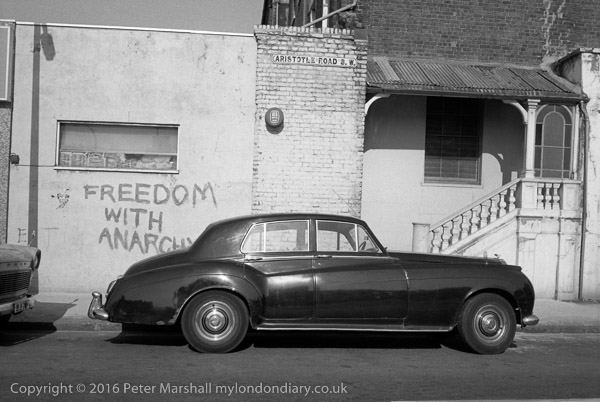
24g-14:
http://londonphotographs.co.uk/london/1980/24g-14.htm
Who could resist going to photograph Aristotle Road – and finding there this graffiti ‘Freedom With Anarchy’?
“Anarchism has but one infallible, unchangeable motto, “Freedom. Freedom to discover any truth, freedom to develop, to live naturally and fully” according to US anarchist, writer, labour organiser and IWW founder Lucy E Parsons (1853-1942), a remarkable woman who was probably born a slave, though she claimed only Native American and Mexican descent. Chicago police described her as “more dangerous than a thousand rioters…”
Books have been written about Aristotle’s concept of freedom, and according to the Oxford Handbook of Freedom he thought that “a person is free to the extent that he is able to live a life of politics and philosophy, and a polis is free to the extent that its institutions promote such a life for each and every citizen by removing the impediments to its realization“.
You can still recognise the location, just off Clapham High St, at the rear of Pearl Pharmacy though the balustrade, roof and stained glass have gone, the road name with its old S.W. is still on the wall. The car parked there back in 1980 was a little unusual, and is I think a T-Series Bentley. I thought at the time it looked a suitable motor for gangsters.
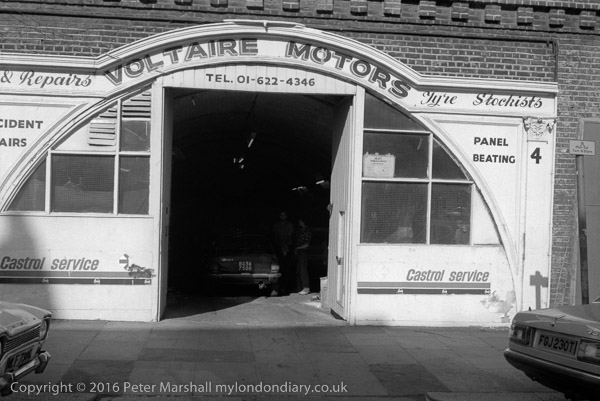
24g-21: railway arch, garage,
http://londonphotographs.co.uk/london/1980/24g-21.htm
Not far from Aristotle Rd is Voltaire Rd, which runs from Clapham High St alongside the railway line and includes Clapham High Street station. Railway arches used to be cheap business properties including many garages such as Voltaire Motors but times are changing. These arches were refurbished around ten years ago and seem now to be largely Artisan Coffee Bars, bars and eateries. I think the arch which used to house this garage became The Bridge Cafe.
Voltaire Motors actually looked considerably better than any of the small row of businesses that now occupy these arches; although the interiors may have been improved by refurbishment the outside has certainly deteriorated since 1980.
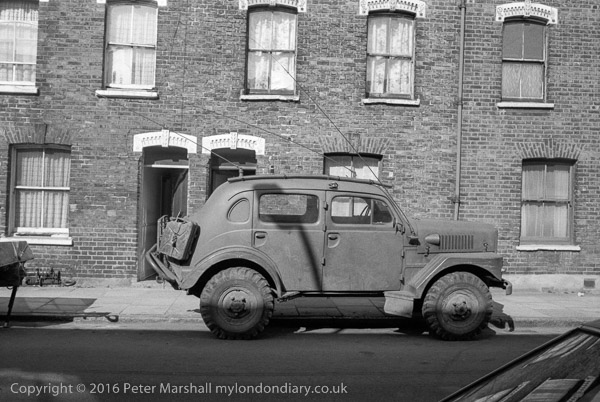
24g-23: houses, terrace, car, military,
From the fairly distinctive decorations above the upper floor windows and doors I think this picture was taken in Lendal Terrace, off Clapham High St, alongside the railway on the other side of road and railway from Voltaire Road.
Experts in military vehicles will probably recognise the vehicle parked here, with a high wheelbase for going off-road. It looks American to me, and vaguely like a Humvee, but I’m almost certainly wrong.
All photographs on this and my other sites, unless otherwise stated, are taken by and copyright of Peter Marshall, and are available for reproduction or can be bought as prints.
There are no adverts on this site and it receives no sponsorship, and I like to keep it that way. But it does take a considerable amount of my time and thought, and if you enjoy reading it, please share on social media.
And small donations via Paypal – perhaps the cost of a beer – would be appreciated.
To be continued…
